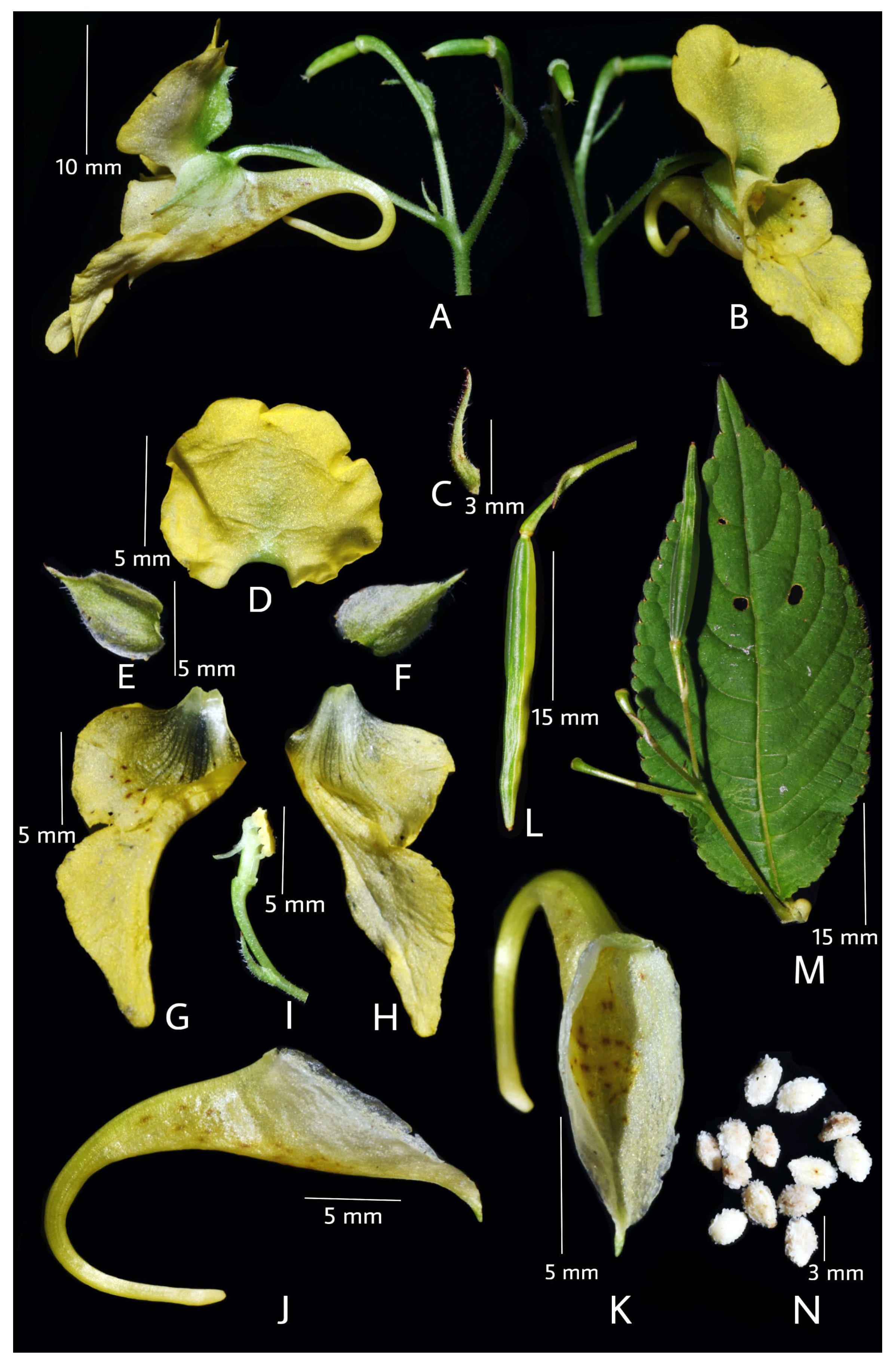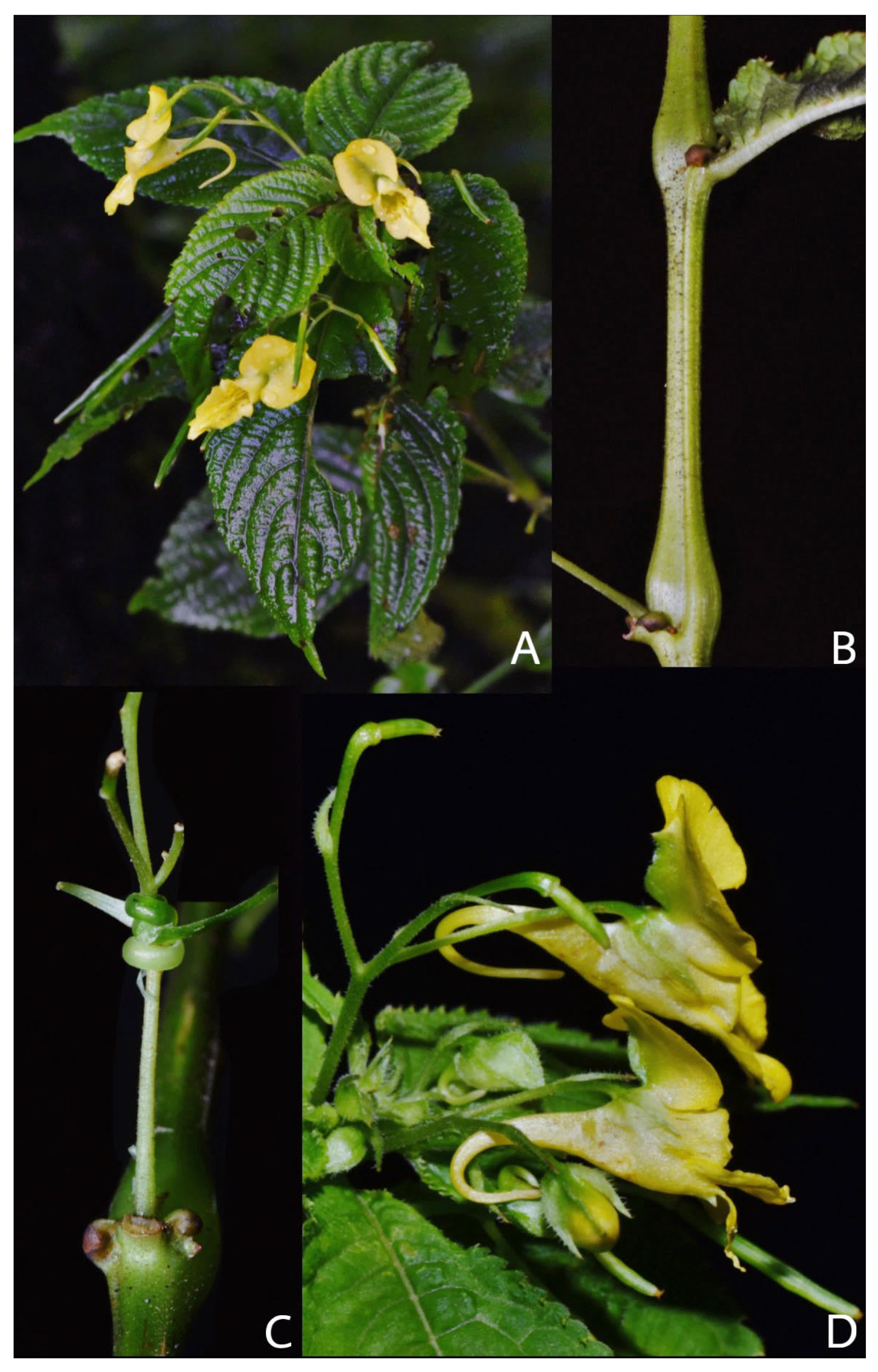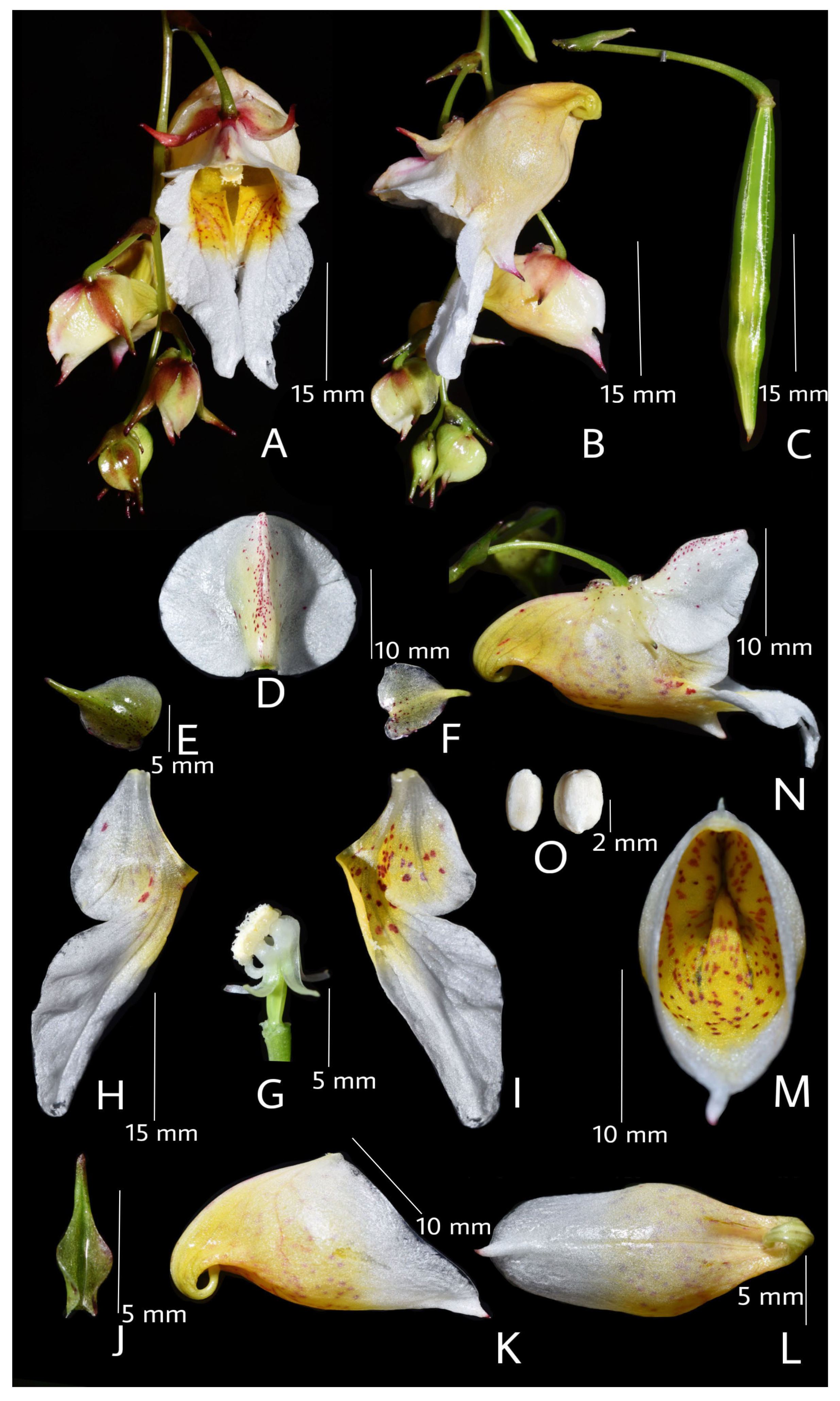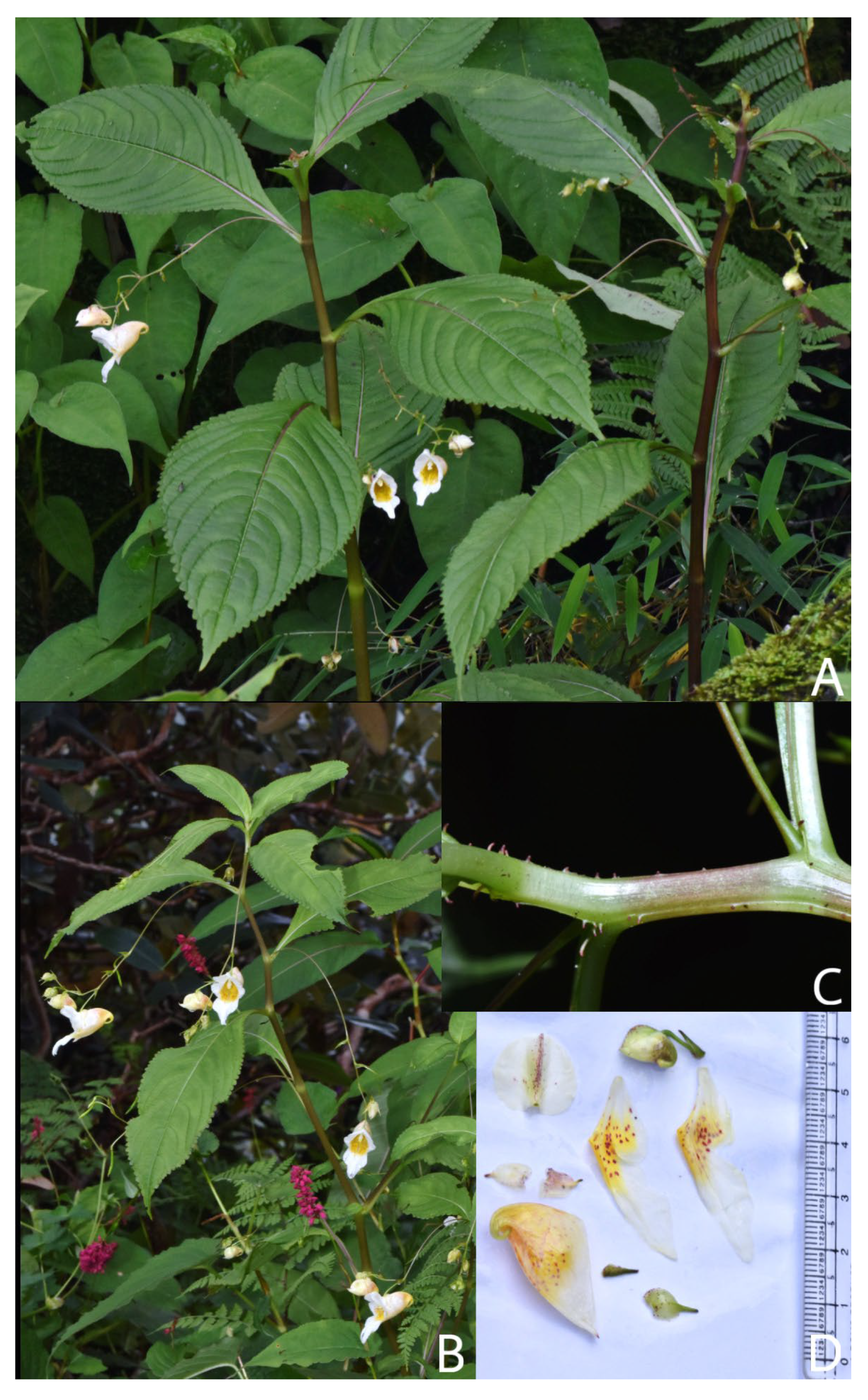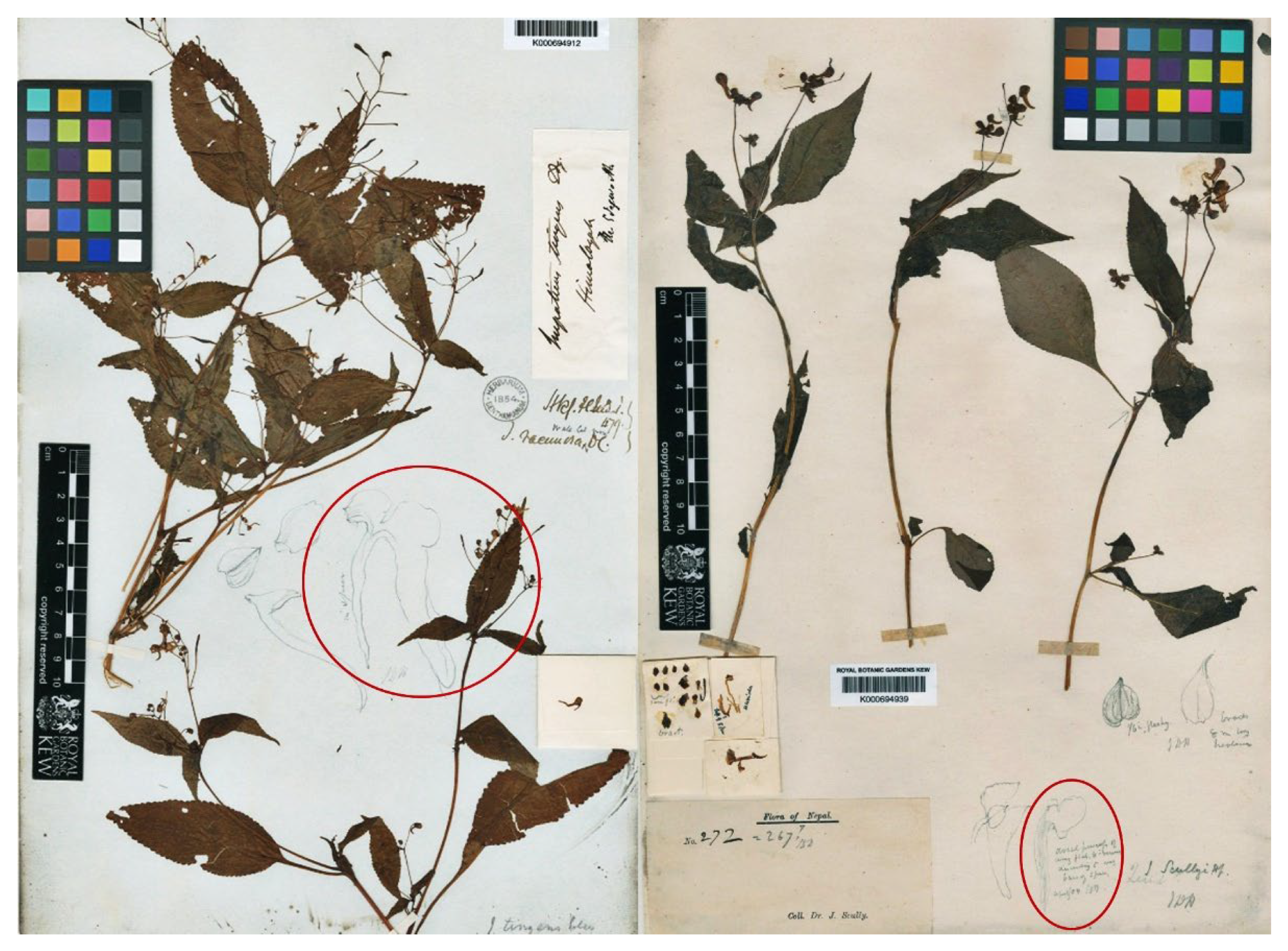3.1. Rediscovery of Impatiens reidii Hook.f., a Rare Presumed Extinct Endemic Species from Its Type Locality After a Gap of 138 Years
Impatiens reidii Hook.f. was described by Hooker [
28] in Hooker’s Icones Plantarum based on a collection made by J.F. Duthie and J.R. Reid from near Sela Darma, Byans, Kali Valley in Kumaon, Uttarakhand. Hooker in his description wrote ‘
inflorescentia pedunculata,
pedunculi pauciflori,
pedicelli infra florem solum bracteati (basi ebracteati),
floribus parvis,
labelli calcare elongato gracile,’ i.e., inflorescence pedunculate, peduncles pauciflorous, pedicels below the flower only bracteate (basally ebracteate), with small flowers, lower sepal with elongate slender spur. Further, Hooker mentioned this as a very distinctive species but did not assign it to any particular group. According to our observations
I. reidii belongs to
I. scabrida group sensu Akiyama and Ohba [
18] having type 7 inflorescence [
29] and pubescent bract in the middle of the pedicel.
Taxonomic treatment
Impatiens reidii Hook.f. in Hooker’s Icon. Pl. 30: sub t. 2901 (1910); Vivek. & al. in Hajra & al., Fl. India 4: 204 (1997); Uniyal & al., Flow. PL. Uttarakhand Checkl.: 91 (2007); Flora of Uttarakhand—1: 875 (2018).
Figure 1 and
Figure 2.
Lectotype (designated here):—INDIA, Uttarakhand, Kumaon, Kali Valley, Byans, near Sela Darma, 6–7000 ft., 16.07.1886, J.R. Reid 2549 (K000694744!).
Description: Annual erect herb, 75 cm long, pubescent, most of the plant parts covered with trichomes, stem green, erect, swollen at lower nodes. Leaves alternate; petiole 1–4 cm long with a pair of round glands (extrafloral nectaries) at the base of petiole; lamina elliptic or obovate, 5–18 × 2–5.5 cm, base gradually attenuate, margins crenate-cuspidate with terminal cusp, apex acuminate, pubescent, main lateral veins 11–14 pairs. Inflorescence pubescent, covered with trichomes, 3–6 flowered, axillary, pedunculate racemes; bracts linear, pubescent with prominent trichomes, 4–6 mm long; peduncles slender, 3–5 cm long, pubescent or puberulous, elongated, stiff in fruiting: pedicels bracteate, 6–10 mm long; bracteole linear-setaceous, 3–5 mm long. Flowers yellow. Lateral sepals 2, obliquely ovate, 6–8 mm long, as broad, acute to acuminate, membranous, pubescent along margins and on slightly raised prominent midrib. Lower sepal shallowly navicular or funnel-shaped, 2–2.5 cm long; 12–14 mm deep; with oblique mouth, spur gradually constricted, filiform, curved, 1.2–1.5 cm long. Upper petal oblong or oblate, 12–14 mm across, back/dorsally green with pubescent crest on midvein. Lateral united petals 15–20 mm long; basal lobes more or less rounded, distal lobes elongated-dolabriform with rounded auricle and obtusely elongated-apiculate lower lobe, brown spotted. Capsules linear, 2.5–4 cm long, erect; seeds oblong, brown, 3–4 mm long, tuberculate.
Flowering and Fruiting: July to October.
Distribution: Uttarakhand, Kumaon (Kali valley) in temperate forests; 2000–2300 m.
Associated species: Achyranthes bidentata Blume, Aster verticillatus (Reinw.) Brouillet, Carpesium abrotanoides L., Clinopodium umbrosum (M.Bieb.) K.Koch, Geranium nepalense Sweet, Girardinia diversifolia (Link) Friis, Persicaria nepalensis (Meisn.) H.Gross, Pilea umbrosa Wedd. ex Blume, Rubia cordifolia L., Selaginella sp. and Urtica parviflora Roxb.
Species etymology: Specific epithet ‘reidii’ is an eponym named after collector Mr. James Robert Reid (J.R. Reid) (Chief secretary, CIE to the government of the Northwest Provinces and Oudh) who collected this species in 1886.
Lectotypification: In the protologue of I. reidii there is no mention of the collection number of herbarium specimens examined but Hooker wrote that ‘I have seen only two specimens—one in herbarium of St. Petersburg, the other in that of Edinburgh’. On consultation at E and LE herbarium we confirmed that currently there exist not any specimen of I. reidii. On detailed search we found that the only sheet of this species is available at K herbarium and information on the sheet exactly matches with the type locality, collector’s name and description of species as given in the protologue. Further on comparison with illustration available in the protologue and pencil drawing made on the herbarium sheet we confirmed that illustration and drawing are identical along with Hooker’s handwriting on sheet and this confirmed sheet at K as original material. Later, in a personal communication with curator at K (Alison Moore) we were informed that ‘collection (K000694744) is, in fact, an Edinburgh collection. It may have been on loan to Hooker who never got round to returning it and it has been incorporated into the Kew collections mistakenly. I have just started the process of returning this collection to Edinburgh, where it will be kept from now on’. Thus, we designate sheet K000694744 as lectotype.
Specimens examined: INDIA, Kumaon: Kali Valley, Byans, near Sela Darma, 6–7000 ft., 16.07.1886, J.R. Reid 2549 (K000694744!); Uttarakhand, Kumaon: Kali Valley, Uttarakhand, Kumaon division, Pithoragarh district, near Birthi waterfall, 30°01′9.63″ N 80°10′35.32″ E, 2055 m, 27.08.2024, Ashutosh Sharma, 12614 (FRLH!); Kumaon: Kali Valley, Uttarakhand, Kumaon division, Pithoragarh district, near Birthi waterfall, 30°01′9.63” N 80°10′35.32″ E, 2055 m, 27.08.2024, Ashutosh Sharma, 12615 (BSS!).
Discussion:
Impatiens reidii is apparently related to
I. tricornis and
I. scabrida, due to annual habit, yellow flowers, plant pubescence and presence of dark, round glands at the base of petiole. It is, however, different from both these species in shape of lower sepal and spur.
I. scabrida is characterized by big flower size, wide lateral united petals, big navicular lower sepal tapering into a long (up to 20 mm) straight downwardly curved spur and pubescent capsules while
I. reidii is having smaller flower size, narrow lateral united petals, smaller lower sepal with short spur not exceeding 15 mm and glabrous capsules. Type specimen of
I. calycina Wall. (=
I. scabrida DC.), only known material of this species, comes from Nepal [
18].
Impatiens tricornis is rather common and highly variable in Western Himalaya, having bucciniform lower sepal abruptly constricted into the spur, its flower color varies from creamy white in lower elevation to dark yellow at higher elevations, plant height up to 4 feet in lower elevations to 15 cm in sub-alpine rocky habitats and puberulent in subtropical habitat to pubescent in subalpine region.
Impatiens reidii could be mistaken with
I. tricornis and
I. scabrida in herbarium material lacking flowers. In Flora of Kullu District, Himachal Pradesh [
25] misidentified
I. tricornis as
I. reidii, we examined the specimens identified as
I. reidii from Beas, Kullu deposited at PUN herbarium and confirmed their identity as
I. tricornis, a common species in Kullu district.
I. reidii is endemic to Kali valley, Eastern Kumaon and probably adjoining western Nepal? Hooker [
28] working with more than 20-year-old herbarium specimens, described flower colour of
I. reidii as white as flower color fades in
Impatiens specimens with time, moreover there are no notes by collectors on color of
I. reidii flowers on type sheet.
3.2. Reinstating Impatiens inayatii Hook.f. and Augmented Description Based on Recollection from Type Locality in Kali Valley, Kumaon, Uttarakhand
Impatiens inayatii Hook.f. was described by J.D. Hooker [
30] based on a specimen collected by Inayat Khan in 1900 in Sosa Forest, Kali Valley in nowadays Kumaon, eastern Uttarakhand, close to the border with Nepal. Hooker’s description is very short: “A remarkable large leaved and flowered species, only once found”, giving no clues about its affinities. Recently Singh et al. [
31] incorrectly synonymised
I. inayatii with distantly related
Impatiens bicornuta without studying live plant material. Our recollection from near type locality confirms the distinct identity and resurrection of this species from
I. bicornuta complex [
32,
33]. Also, on detailed search across different herbaria we came across a recent collection of this species from Seti zone of Doti District in far West Nepal housed at Royal Botanic Garden Edinburgh herbarium (E) and this forms a new record for the Flora of Nepal.
Taxonomic treatment
Impatiens inayatii Hook.f. in Rec. Bot. Surv. India 4: 10 (1904); Vivek. & al. in Hajra & al., Fl. India 4: 157 (1997); Uniyal & al., Flow. Pl. Uttarakhand Checkl.: 91 (2007); Flora of Uttarakhand—1: 870 (2018).
Figure 3 and
Figure 4.
Lectotype: INDIA, Uttarakhand, Kumaon, Kali valley, Sosa forest, 8000–9000 ft., 17 September 1900,
Inayat 23987 (K000694900!); Isolectotype DD. (Designated by Singh et al. [
31]).
Annual erect herb, 40—130 cm tall; glabrous. Stem glabrous, green to dark purple, slightly swollen at nodes, up to 2 cm wide at the base and hollow inside. Leaves thick coriaceous, glabrous, alternate; petioles 0.5–6 cm long; lamina ovate-elliptic to ovate-lanceolate or elliptic-oblong, 15–25 × 5–8 cm, base attenuate, margins crenate to deeply crenate with glandular cusps, apex acuminate; main lateral veins 7–10 pairs. Few to many small filiform glands at the base of petiole and mostly on the apical branches, 1–2.5 mm long. Inflorescences pendulous racemose, up to 15 cm long, ascending at tip, 2–8 flowered. Flowers large, up to 3 cm long, white and yellow with dark red rusty spots inside, pedunculate; bract at the base of pedicel, glabrous, persistent, ovate-lanceolate, 7–8 × 3 mm; peduncle slender, 5–14 cm long, glabrous; pedicels opposite, arcuate when fruiting. Lateral sepals one pair, green turning to translucent white with small red spots in mature flowers, ovate, 8 × 6 mm; appendaged at apex. Lower sepal bucciniform, 2.5 × 3 cm; with oblique mouth, mouth with short beak, basal part yellow inside with red-brown spots, spur gradually constricted and curved inside such that it reaches depression formed at the base of lower sepal, 5 mm long. Dorsal petal white with small red spots on dorsal side, 11 × 15 mm, suborbicular-obcordate; crested, crest up to 2 mm, lateral united petals 8–10 × 32–35 mm with yellow splash and dark spots on sinus of basal and distal lobes; basal lobes broadly triangular; distal lobes narrowly ovate, narrowed just above the middle, shortly apiculate. Auricle inconspicuous. Capsules linear, acute, 3–4 cm long. Seeds 3–5, ovoid to oblong, 4–5 mm long, surface smooth and glabrous, brown at maturity.
Flowering and Fruiting: July to October.
Distribution: Kumaon (Sosa, Kali valley) and far West Nepal, in temperate to sub-alpine forests; 2600–3730 m.
Associated species: Ainsliaea aptera DC., Aster verticillatus (Reinw.) Brouillet, Semple & Y.L.Chen, Bistorta amplexicaulis (D.Don) Greene, Geranium wallichianum D.Don ex Sweet, Halenia elliptica D.Don, Impatiens amphorata Edgew., Impatiens laxiflora Edgew., Quercus semecarpifolia Sm., Rhododendron campanulatum D.Don and Rubus nepalensis (Hook.f.) Kuntze.
Species etymology: Specific epithet ‘inayatii’ is an eponym named after collector Inayat Khan (Head plant collector of the Botanical Department of N. India) who collected this species in 1900.
Specimens examined: INDIA, K000694900!, Kumaon, Kali valley, Shosa forest, 8000–9000 ft., 17.09.1900, Inayat 23987; CAL0000005156!, Kumaon, Kali valley, Shosa forest, 17.09.1900, Inayat 23987; FRLH12605!, Uttarakhand, Kumaon division, Pithoragarh district, on way to Khaliya top, 30°3′51″ N 80°12′28″ E, 3275 m, 23.08.2024, Ashutosh Sharma, 545; FRLH12604! Uttarakhand, Kumaon division, Pithoragarh district, on way to Khaliya top, 30°3′42″ N 80°12′54″ E, 2900 m, 23.08.2024, Ashutosh Sharma, 546.
NEPAL, E00623967!, Far Western Development Region, Seti Zone, Doti District, Khaptad National Park. Trail from Jhigrana to Bichpani, 29°20′37″ N 81°3′25″ E, 2668 m, 01.07.2009, Nepal Bajhang Expedition 2009 H. Ikeda et al. 20911026; E00509740!, Far Western Development Region, Seti Zone, Bajhang District, above Surma village, 29°39′24″ N 81°5′36″ E, 3386 m, 08.07.2009, Nepal Bajhang Expedition 2009 H. Ikeda et al. 20911089; E00509971!, Far Western Development Region, Seti Zone, Bajhang District, on the trail between Dhahidunga Kharka and Manane Lekh, 29°37′27″ N 81°0′29″ E, 3730 m, 13.07.2009, Nepal Bajhang Expedition 2009 H. Ikeda et al. 20911119.
Discussion: Akiyama [
9] and Raskoti & Ale [
21] didn’t mention
I. inayatii in the flora of Nepal. Based on morphological evidence, i.e., inflorescences pendulous, racemose, with few to many flowers (type 2a and 2b inflorescences: [
29] and leaves thick coriaceous) we include
I. inayatii to section
Urticifoliae S.Akiyama & H.Ohba [
17]. Members of this section were not reported earlier from Western Himalaya.
Raskoti & Ale [
21] recently described morphologically closely resembling species,
Impatiens nimspurjae Raskoti, with white and yellow flowers from western Nepal.
Impatiens nimspurjae has however smaller flowers (1.5–2 cm long), sessile leaves and shorter inflorescences (2–3-flowered and peduncle 1.5–6 cm) but authors didn’t compare the newly described species with
I. inayatii to which it seems to be more closely allied morphologically. Further integrated morpho-molecular studies are necessary to resolve species delimitation and relation between these taxa.
Recently
I. inayatii was synonymized with
I. bicornuta by [
31]. This paper was however heavily criticised [
34], as illustrations of
I. bicornuta sensu [
31] include also members of
I. urticifolia group sensu [
17].
I. bicornuta complex is characterised by multiflowered interrupted and erect raceme inflorescences, with pseudowhorls of flowers in lower part of inflorescence (
I. bicornuta) while in
I. urticifolia group (incl.
I. inayatii) inflorescences are drooping, ascending (Type 2a and 2b inflorescences) [
29] and thick, coriaceous leaves. Separation of
I. bicornuta group and
I. urticifolia group was confirmed in phylogenetic study by [
5]. However, according to molecular study of [
21],
I. nimspurjae is more closely related to
I. radiata and
I. racemosa than to
I. urticifolia.
3.3. Synonymizing Impatiens scullyi Hook.f. with Impatiens tingens Edgew.—Insight into Botanical History and Identity Confusion of Names Impatiens tingens Edgew. with Impatiens racemosa DC. and Impatiens laxiflora Edgew
Recently Sharma et al. reported
Impatiens scullyi Hook.f. as a new record for India [
22]. The species was first collected by J. Scully from Nepal and was mentioned by Sir J.D. Hooker in “An epitome of the British Indian Species of
Impatiens” [
30] from central Nepal. It was described in detail later by [
34] from central and eastern Nepal. Western Himalayan floras [
12,
13] report
I. tingens, originally described by [
35]. Further studies of literature [
30,
35,
36], type specimens of both taxa, pictures, live material and recollection of
I. tingens by first author (A.S.) from type locality (
Figure 5) confirm that
I. tingens and
I. scullyi share one rare feature: long auricle from base of lateral united petals inserted into spur [
37]. This feature is known to occur only in about a dozen of species from continental Africa, Western Ghats and China [
1,
38,
39]. Further examination of type specimens of both species revealed that there are no consistent differences between the taxa (
Figure 6). Hence, following the principle of priority (Article 23 ICN) we synonymise later published name viz.
I. scullyi under
I. tingens.
Taxonomic Treatment:
Impatiens tingens Edgew. Trans. Linn. Soc. London 20 (1): 41 (1846); Duthie, Cat. Pl. Kumaon: 254 (1906); R.K. Gupta, Living Himalaya 2: 64 (1989); Flora of Uttarakhand—1: 878 (2018).
Figure 5 and
Figure 6.
Lectotype (designated here): INDIA, Western Himalaya, Nagkanda, [Kugun], 7000–10,000 ft., 1844, M.P. Edgeworth 339, [K006367081!]; Isolectotypes K [K000694911!], K [K000694912!], K [K006367079!]).
=Impatiens scullyi Hook.f. in Rec. Bot. Surv. Ind. 4: 15 & 21 (1905) syn. nov.; Hara in Hara & Williams, Enum. Flow. Pl. Nepal 2: 80 (1979); Akiyama et al. Bull. Univ. Tokyo No. 34 (1991); Yu Balsaminaceae of China: 140 (2012).
Holotype: Nepal, Scully J. 272 (K000694939!).
=Impatiens laxiflora var. stracheyi Hook.f. in Fl. Brit. India 1: 480 (1875).
Lectotype (designated here): India, Simla (Fagu), T.T. s.n. [K006367068!]; Isolectotype K [K006367069!].
Annual herbs, 30–120 cm tall, stem succulent, swollen at nodes, often rooting from lower nodes, leaves alternate, aggregated at the apical part of stem, petiole 10–20 mm long, lamina broadly lanceolate to oblong-ovate, 8–14 cm long, 4–6 cm wide, glabrous with crenate margin. Inflorescence racemose, 6–13 cm long, axillary, with six to ten flowers, flowers congested on top of peduncle. Pedicel 1.5–2 cm long, slender, glabrous, with a bract at base. Bracts 3–4 mm long, narrowly ovate, acute at apex. Stipulary glands many, filiform, small, 1–2 mm on apical branches and usually two big prominent (upto 3 mm) at the base of petiole. Flowers 1.4–2 cm long, 1.2–2.8 cm deep. Lateral sepals two, ovate, 3–4 mm long. Lower sepal greenish, white or rosa, 4–7 mm long, 12–20 mm deep, tubular; spur inconspicuous. Dorsal petal white, rosa or pale purple, 4–6 mm long and 6 mm wide when flattened, cucullate, with thickened greenish midrib, ending in a short horn or appendage. Lateral united petals white, rosa or rarely purple colored with yellow spot at the base of lower lobe, 11–14 mm long; the upper lobe ovate, ca. 3 mm long and ca. 2 mm wide; the lower lobe with two rounded lobes, 9–11 mm long and 5–6 mm wide, with a very characteristic long appendage (9–13 mm long) elongating into the tubular lower sepal. Stamens five, anthers without appendage. Capsule 1.5–3 cm long, unevenly linear, green with pale yellowish stripes, enclosing 2–6 seeds. Seeds 3–4 mm long (
Figure 5).
Lectotypification.
Impatiens tingens was described by M.P. Edgeworth [
35] based on his own collections from Nagkanda (Narkanda) and Dhobri (Shimla, Himachal Pradesh). In the protologue there is no mention of collection numbers and herbarium but on detailed search across major herbaria (K, E, CAL & DD) we came across four sheets by Edgeworth from dates preceding the description collected from Shimla with Edgeworth’s handwriting/signature thus confirming same as original material. Out of these four sheets K006367081 with notes and illustration of dissected flower (showing characteristic long appendage) best matches with the description and thus is designated as lectotype and the other three sheets as isolectotype (K006367079, K000694911, K000694912).
Synonymisation. Some sources treat the name
I. tingens as a synonym of
I. laxiflora [
40].
I. tingens was previously also confused with
I. racemosa due to much similarity in flower shape and size as from the frontal side both species may look much similar however still one can easily differentiate both based on its flower color and shape of spur. More importantly
Impatiens racemosa has inconspicuous auricle and this way could not be synonymous with
I. tingens (compare [
30], p. 6). There was a lot of misunderstanding around
I. tingens: Hooker & Thomson [
41] described it as yellow flowered, but from description it looks as an aggregate of more than one taxon. In Flora Simlensis [
42] Collett described
I. tingens as
I. racemosa where he mentioned unique appendage of lateral united petals as ‘wings (lateral united petals) produced in a long, linear tail descending into the spur’ not found in any other Western Himalayan balsam. Basu & Uniyal [
12] also describe
I. tingens as yellow flowered, but [
13] describe it as white flowered. On the other hand, neither [
12,
13] mention long auricle in their descriptions. Edgeworth [
35], Hooker [
30], and Akiyama et al. [
36] described
I. tingens (=
I. scullyi) as variable in flower color, size and shape of spur. Hooker [
30] describes auricle in
I. tingens as filiform; in
I. scullyi as linear. However, comparison of type specimens and sketches by J.D. Hooker (
Figure 6) shows clear similarity in long auricle arising from the base of lateral united petals entering lower sepal/spur.
After description
I. tingens was mentioned by Stewart [
43] in his book ‘Punjab Plants’, describing its usage in Lahaul he states ‘
This species, so named by Edgeworth from its coloring his herbarium paper yellow, is a common weed in Lahoul, where Aitchison states that an oil is expressed from the seeds, only to be used, however, for polishing the cups made by the inhabitants from the knots of chiefly Acer perhaps imported from further down, as on the Satluj’.
Impatiens racemosa was first described by De Candolle [
44]. Hooker and Thomson [
41] (p. 147) mentioned that ”
Under I. racemosa in Wallich’s Herbarium there are at least three plants, viz., I. leptoceras and the two others, which appear to differ chiefly in the racemes of one being interrupted whorled, and of the other continuous: as Mr. Edgeworth has described the latter under the name of I. tingens, I have retained Wallich’s name for the former. The I. tingens, Edgeworth, appears to differ in no respect from this and from specimens marked I. racemosa in Wall Herb., except in the flowers not being verticillate, and in the remarkable character of the posticous lobes of the lateral petals (alae) being included into the spur, which I cannot but regard as an anomalous character. The whorled pedicels, numerous long erect racemes, small flowers and straight spur best distinguish racemosa”. So, Hooker and Thomson described
I. laxiflora flowers as yellow and pink because they were treating collections of three species i.e.,
I. racemosa (=
I. laxiflora var.
khasiana),
I. tingens (=
I. laxiflora var.
stracheyi) and true
I. laxiflora.
Hooker and Thomson [
41] pointed out unique anomalous character of
I. tingens and wrote ‘one lobe is developed in aestivation within the spur.’ Further they wrote under
I. tingens ”In some of the specimen I found the posticous lobes of the lateral petals (which are extremely variable in form and shape) included in the spur, as described by Edgeworth; in others they are free, and I am disposed to regard the former arrangement as owing to an anomalous form of the petals, which are normally simply and shortly 2-lobed as in
I. racemosa and others”.
In 1905, J.D. Hooker while summarizing
Impatiens in the Indian subcontinent in a series of papers as “An Epitome of British Indian Species of
Impatiens” [
30] excluded all the varieties from
I. laxiflora.
Impatiens laxiflora var.
stracheyi Hook.f. was synonymized with
I. tingens Edgew. and it was mentioned that this species is distributed from Western Himalaya to eastward up to Central Nepal.
Impatiens micranthemum Edgew., Trans. Linn. Soc. London 20: 40 (1846).
Lectotype (designated here): INDIA, Himalaya, Kranda, 8000–9000 ft., 1844, M.P. Edgeworth 338, [K006366299!].
Edgeworth [
35] described many new species from northwestern India based on his own herbarium collection. For most species, he had not only herbarium specimens but also the notes taken from living plants at the time of collection. One of these species is
Impatiens micranthemum Edgew. [
35] (p. 40), in most sources, it is treated as a synonym of
I. laxiflora Edgew. [
35] (p. 40); [
19,
30,
45]. It was described as having predominantly white or whitish flowers, but inflorescences with 3–4 flowers, stems with sparse black glands and round lower lobe of lateral united petals. These features clearly differentiate it from
I. scullyi, as described by [
30,
36]. There is, however, nothing in Edgeworth’s description of
I. micranthemum about a long appendage on lateral united petals, characteristic of
I. scullyi (=
I. tingens) [
36] and very rare in other species of the
Impatiens genus.
Identity of name Impatiens micranthemum as I. laxiflora is here confirmed by first author (A.S.) after recollecting I. micranthemum from its type locality near Hatu Peak, Narkanda, Shimla district, Himachal Pradesh where the lower elevation limits of this species descend with the I. tingens population.
Geographical distribution.
Impatiens scullyi was regarded as confined to Nepal in the newest list of endemic plants of this country [
46,
47], however, [
48] reported it from southern Tibet (Xizang).
Impatiens tingens was described from Nagkanda (nowadays Narkanda, Shimla district, Himachal Pradesh) and Dhobri [
35], and reported from Western Himalaya [
12,
13] from Himachal Pradesh to Uttarakhand. Hooker [
30] reported
I. tingens also from Nepal, but newer literature confirms only
I. scullyi [
9,
21,
36,
46,
49] from this country. Thus
I. tingens is distributed from Himachal Pradesh and Uttarakhand in India to Central Nepal and southern Tibet.
Specimens Examined—
INDIA, K006367069!, Busur (Bushahr), 7300 ft., M. Madden s.n.; K006367070!, Shimla, between Nagkanda & Khotgarh, 30.09.1831, C.B. Ramsay (Lady Dalhousie) s.n.; K006367080!, Western Himalaya, Garhwal, 7000 ft., F.B. Dickinson s.n.; K006367081!, Himalaya, Nagkanda, [Kugun], 7000–10,000 ft., 00.00.1844, M.P. Edgeworth 339; K000694912!, Simla, below Nagkanda, 8000–9000 ft., M.P. Edgeworth s.n.; K006367079!, Himalaya, 7000–10,000 ft., 00.00.1844, M.P. Edgeworth s.n.; K000694911!, Himalaya, Simla, below Nagkanda, M.P. Edgeworth s.n.; E00848289!, Simla, Sungri, 00.09.1888, George Watt 8656; FRLH124715!, Himachal Pradesh, Shimla District, Narkanda, 31.15070 N & 77.28050 E, 2650 m, 14.09.2021, Ashutosh Sharma 652; BSS124716!, India, Himachal Pradesh, Shimla District, Narkanda, Below Hattu Peak, 31.15060 N & 77.28540 E, 2805 m, 14.09.2021, Ashutosh Sharma, 658; DD172573, Himachal Pradesh, Mandi District, Dhaved (near Khanni), 31.6530 N & 77.2830 E, 1600–1900 m, 04.08.2018, Ashutosh Sharma s.n.; DD172574! Himachal Pradesh, Kullu District, Jhuni, 31.8700 N & 77.3240 E, 1800–2100 m, 15.08.2018, Ashutosh Sharma s.n.; DD 128670! India, Uttarakhand, Chakrata forest division, Kathyan—Mundali 2070 m, 4.10.1958, K.C. Sahni 26818; DD 128670!, India, Uttarakhand, Chakrata forest division, Kathyan—Mundali 2070 m, 08.08.1958, K.C. Sahni 71231; NEPAL, KATH005907!, Nepal, Rasuwa District, Lingju Tibling, 28012′ N & 85007′ E, 2040–2130 m, 12.08.1994, F. Miyamoto, K.R. Rajbhandari, S. Akiyama, M. Amano, H. Ikeda & Y. Tsukaya 9420261; KATH030467!, Nepal, Mardi Khola, 2280 m, 16.09.1954, Stainton, Sykes & Williams 8427; E00848293!, Nepal, Gurjakhani, 2590 m, 12.09.1954, Stainton, Sykes & Williams 4367; E00848290!, Nepal, Bhujihola, 2440 m, 15.10.1954, Stainton, Sykes & Williams 9043.
